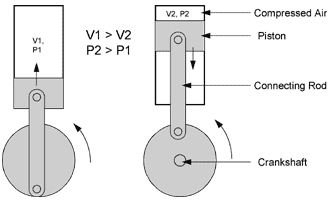How does an air compressor work on board ships?
Introduction
An air compressor is a very useful machine and is not only used extensively in industry on land but on all types of ships as well. On a ship an air compressor is used to compress air and store it in tanks for various uses. These use these could range from simple processes such as cleaning and drying of filters to tasks such as starting the auxiliary engines and the main engines of the ship.
How does an air compressor work?
How does an air compressor work?
In this section we will try to understand how an air compressor works. First of all and let me explain what compression means. It simply refers to the process of reducing the volume of gas so as to raise its pressure and the compressed gas is stored in a solid container or tank usually having a pressure gauge and the safety mechanism. Just notice that I have used the word gas which is obvious since the solids and liquids are incompressible.
Compressors can be of several types such as a rotating, reciprocating, centrifugal, screw type and so forth but we will focus mainly on the reciprocating and rotary compressors in this article. The basic construction of a reciprocating compressor is similar to that of an internal combustion engine. It consists of the familiar piston and cylinder arrangement, having inlet and outlet valves for the entry of normal air and the exit of compressed air respectively. The other component is present in the bigger engines such as the connecting rod and the crankshaft are also their in the reciprocating compressor. This arrangement is depicted clearly in the diagram shown alongside and you can see the various parts which have been described here. The more the power required from the compressor, the greater the number of cylinders in it.
The other diagram shows the various parts of a reciprocating compressor lying opened up. Can you identify the various parts I have listed above?
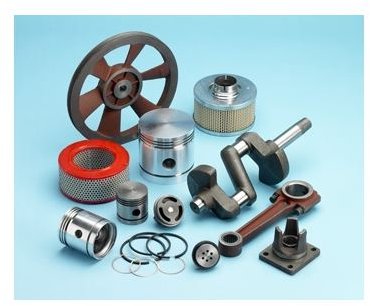
The compressor is driven by an external power source which is normally an electric motor. The image below shows an air compressor which is very small in size. It also shows the various components such as the compressed air tank and the electric motor.
Small Compressor Unit
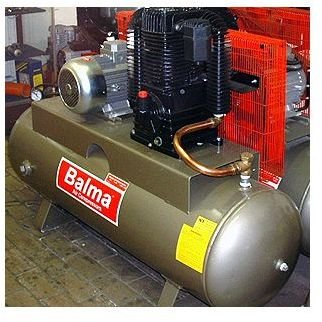
Rotary Compressors
Now we will take a very brief look at one more type of compressors namely rotary compressors. As the name itself suggests, and these compressors have the rotary motion instead of reciprocating motion of the internal parts responsible for compressing the air. Shown below is the cut out of a twin lobe rotary compressor which consists of two lobes or impellers which rotate in unison but in opposite directions. The air which gets trapped inside gets reduced in volume hence completing the compression process.
Normally rotary compressors consume less energy for motive power but reciprocating compressors are more powerful and hence used for heavy duty purposes.
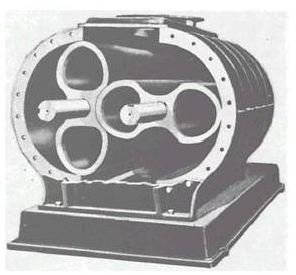
Multistage Compression
In case the compression required is more, the compressors come in more than one stages. Since it is a law of thermodynamics that when sudden compression takes place, temperature rises. The graph of pressure against volume for a reciprocating compressor is shown below.
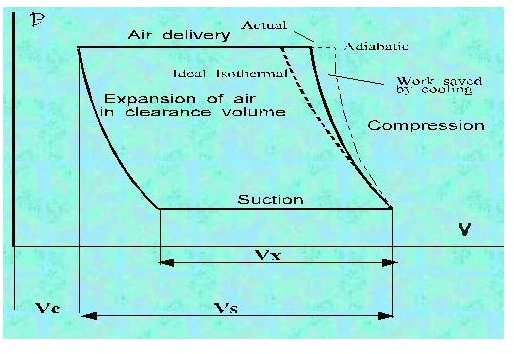
Hence the air needs to be cooled before being passed on to the next stage and this is done using intercoolers. Of course there is also an after cooler which is used to cool the air before it is passed on to the storage tank.
There are several advantages to use multistage compression instead of a single large compressor including use of smaller sized stages than a single large stage, low compression ratio for each stage and enhanced lubrication properties. Shown below is a reciprocating type two stage compression system showing all parts such as intercooler, aftercooler, motor and so forth.
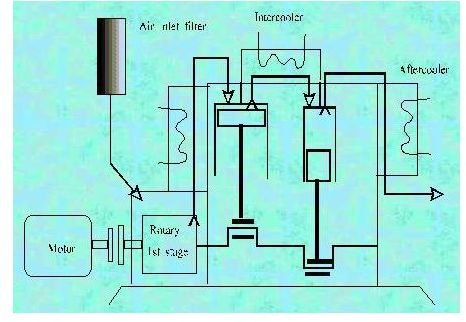
The intercooler and after-cooler are form of heat exchangers used on ships.
Image Credits
Marine Engineering Knowledge by Brian Beattie
Balma Compressors Company
Integrated Publishing, Florida
Air Compressor Consortium
